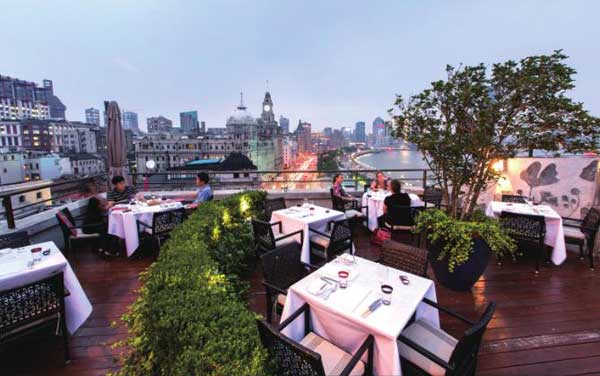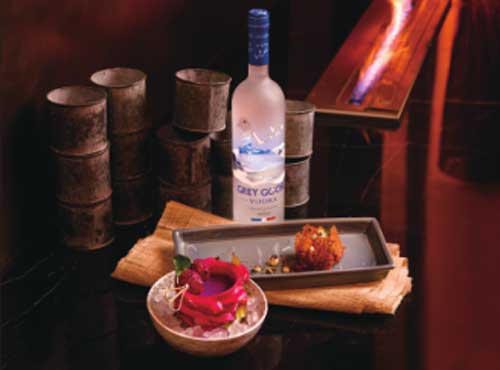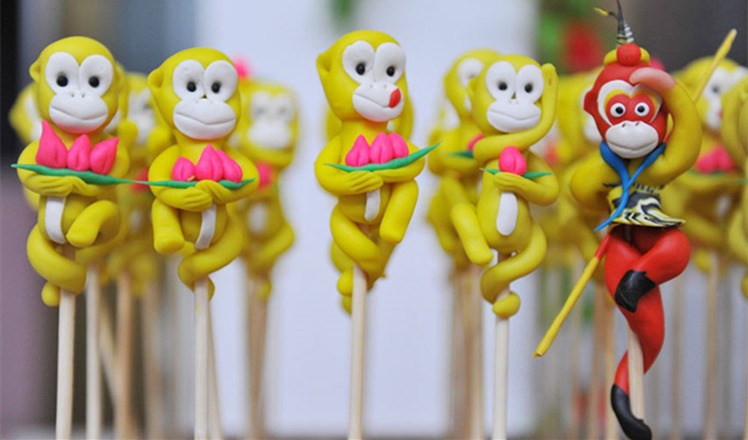A palatable change for the Bund
Updated: 2016-01-09 03:14
By XU JUNQIAN in Shanghai(China Daily USA)
|
||||||||
 |
|
A view of M on the Bund, the fi rst fi ne dining retaurant to appear along Shanghai's most famous tourist stretch. (Below) A food and alcohol pairing at The Nest, a gastro lounge on the Bund that has been very popular with locals. PHOTOS PROVIDED TO CHINA DAILY |

The clock tower atop the Custom House on the Bund, Shanghai's famous waterfront stretch that represents the city's glorious past and its current position as China's financial capital, has just chimed six times. It is the start of the evening rush hour, and crowds are pouring onto the streets as people either make their way home or to the pubs and restaurants for happy hour drinks.
As the banks and trading houses within the regal old buildings along the Bund draw their shutters and lock their doors, tourists are whisked away by their loudspeaker-toting tour guide back to a bus before they depart for another destination. The sun has already set, and after the crowd numbers dwindle within the hour, the Bund will surrender its buzz to the night.
"The weird thing about the Bund is that everyone knows it and likes it, but the locals hardly visit it," said Wang Chih-Jen, an executive within the development and management team at Bund 5.
Statistics from the municipality show that the waterfront area, which runs along the western shore of the Huangpu River, receives a total of 600,000 to 900,000 visitors every day, but only about 10 percent of them are locals. The transportation commission also estimates that 80 percent of the vehicles moving along the six-lane road every day at the Bund are merely passing through and not heading toward any attractions or restaurants in the area.
A place for everyone
But the situation is set to change. Real estate developers, restaurateurs and the city's government officials are looking to turn the waterfront stretch into a prime dining area for not just wealthy tourists but locals as well, and the building known as Bund 5 looks to be the magnet to do so.
The six-storey building, constructed in the 1920's as the headquarter of Nisshin Kisen Kaisha, Japan's largest shipping company in China, will be the first along the waterfront to exclusively house dining establishments. A total of ten restaurants, which will offer cuisines ranging from southern American steaks, hot pot, Cantonese dim sum and western fine dining, will occupy the building, which has a facade featuring Japanese and neo-classical elements.
There is no shortage of dining places at the Bund. There are upwards of 100 restaurants in the area — many of them belonging to the upscale category — including those operated by the five-star hotels in the vicinity, according to authorities of the Huangpu district, where the Bund is located. Dozens more are expected to open in the next few years.
Besides factors such as traffic congestion and limited parking spaces, Wang said that the Bund's inability to maintain the crowd numbers come nightfall is also due to a stereotype that many locals have about the location — that it is an intimidating area where only rich people and foreigners can afford to be in.
This stereotype is not completely unfounded. After all, the Bund is where Michelin-starred chef Jean-Georges Vongerichten runs his swanky establishments such as Jean-Georges and Mercato. The area is also home to Paul Pairet's Mr and Mrs Bund, a modern French restaurant where customers usually spend at least $100 per person during dinner. Pairet's Ultraviolet, dubbed as a revolutionary, multisensory restaurant, costs a whopping 4,000 yuan ($613) per person.
In order to pull in the crowds, Wang said that the meals served by restaurants in Bund 5 will be friendlier on the wallets.
"The average cost per person at most of the restaurants in Bund 5 will be around 300 to 500 yuan, an affordable amount to spend for important celebrations or occasions once every few months," he said.
At the beginning
Michelle Garnaut, an Australian restaurateur and chef, is all too familiar with the changes in the area over the years, saying that the scene today, despite the fall in crowd numbers, bears a stark contrast to the days when she first opened the M on the Bund restaurant in 1999.
"When I decided to open a restaurant here, everyone warned me that nobody was ever gonna eat on the Bund," said Garnaut. "For the first five years, we were all alone in this area, which was a dark and dingy place that barely had anything else."
For a long time, M on the Bund was the go-to culinary destination that was visited by a galaxy of prominent figures like the United Kingdom's Prince Edward, media tycoon Rupert Murdoch, and Harry Porter actor Daniel Radcliffe. It was not until 2004, when Taiwan entrepreneur Vanna Teng turned the former Standard Chartered Bank Building into a department store-like property that combined luxury shops, art galleries and fine dining places, that the century-old place started to gain a buzz.
For years after, plush fashion boutiques and jewelry stores transformed the Bund into the acme of luxury shopping in China. However, with the slowdown of the luxury industry in recent times, major consumer brands such as Patek Phillipe, Giorgio Armani and Hugo Boss started to vacate the premises while restaurants gradually began to enter the scene.
Mark Klingspon, the managing director of The Nest, a gastro lounge along the Bund, is another person who has witnessed the transformation of the area.
"I used to travel a lot to Hong Kong for business when I first came to China seven years ago. I always felt that Hong Kong was so cool with all the restaurants and food, and I thought Shanghai was a hundred years away from achieving that. I didn't think that Shanghai could catch up in my lifetime," said Klingspon.
An example to follow
If there is one establishment the new restaurants at Bund 5 can emulate, it would probably be The Nest, which became an instant hit with the locals when it opened in Dec 2014. The lounge is the product of a collaboration between nightclub brand Muse Group and French vodka brand Grey Goose.
Located slightly away from the central areas of the Bund, this classy, relaxed lounge has earned itself a reputation for quality cocktails and creative culinary creations that don't come with price tags locals would scoff at. Besides Klingspon, the team comprises experienced hands such as Christoffer Backman, formerly from the Waldorf Astoria in Shanghai, Carson Xie, a bartender who had worked at Park Hyatt hotel, as well as French chef Freddy Raoult.
According to Klingspon, more than 80 percent of the guests frequenting his venue are young Chinese professionals, most of whom work for international brands and companies. He also added that The Nest has enjoyed double-digit growth for 11 consecutive months and the place is often booked out several weeks in advance.
"We are either very lucky or we did something right. I think we have connected to a guest demographic that most restaurants would dream of attracting," said Klingspon.
"These are not the young rich Chinese that come here in their Lamborghinis and just want to have the most expensive things on the menu. What we have here at The Nest is real people, those who come here to experience new food and drinks. You cannot sustain a business in today's market without the real people," added Klingspon.
With regard to the dining scene at the Bund and what could be done to enliven it, the Canadian believes that the competitive food industry in Shanghai will keep restaurateurs on their toes and in time help to inject more vibrancy.
"Some years ago, people didn't care much about what they were fed or how much they were charged as long as they had the view of the Bund," said Klingspon.
"Now, you need to offer a quality product in order to survive here."
- Obama says US must act on gun violence, defends new gun control rules
- Over 1 million refugees have fled to Europe by sea in 2015: UN
- Turbulence injures multiple Air Canada passengers, diverts flight
- NASA releases stunning images of our planet from space station
- US-led air strikes kill IS leaders linked to Paris attacks
- DPRK senior party official Kim Yang Gon killed in car accident

 Special report: Rise and rise of China's outbound tourism
Special report: Rise and rise of China's outbound tourism
 Trial data of former senior Party officials on display
Trial data of former senior Party officials on display
 Replica of luxurious chariot from ancient times wows Xi'an visitors
Replica of luxurious chariot from ancient times wows Xi'an visitors
 Number of giant pandas in China reaches 422
Number of giant pandas in China reaches 422
 Attendees feel the thrill of tech at CES trade show
Attendees feel the thrill of tech at CES trade show
 Vivid dough sculptures welcome Year of the Monkey
Vivid dough sculptures welcome Year of the Monkey
 Kidnapped five-year-old reunites with her family 56 hours later
Kidnapped five-year-old reunites with her family 56 hours later
 Kung Fu Panda hones skills from master
Kung Fu Panda hones skills from master
Most Viewed
Editor's Picks

|

|

|

|

|

|
Today's Top News
Shooting rampage at US social services agency leaves 14 dead
Chinese bargain hunters are changing the retail game
Chinese president arrives in Turkey for G20 summit
Islamic State claims responsibility for Paris attacks
Obama, Netanyahu at White House seek to mend US-Israel ties
China, not Canada, is top US trade partner
Tu first Chinese to win Nobel Prize in Medicine
Huntsman says Sino-US relationship needs common goals
US Weekly

|

|







